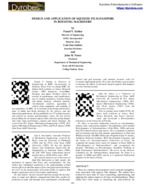Papers
“Design and Application of Squeeze Film Dampers in Rotating Machinery,” |
Abstract
There are common misconceptions and occasional misapplications associated with squeeze film dampers. The authors have worked for more than 25 years researching, experimenting, and applying this subject matter to all types of turbomachinery. Major strides have been made in advancing the state-of-the-art by accounting for the fluid inertia effects in the analysis of squeeze film dampers. These effects are very important at high speeds and high temperatures (high squeeze film Reynolds numbers) due to the dominance of the inertial effects in comparison to the viscous effects. A comprehensive discussion is provided of squeeze film dampers, outlining their major advantages and the proper use of these components.
Since squeeze film dampers are more complex to design and analyze than other machinery elements, they have often been used in the process industry as a last resort to reduce vibration or improve the rotordynamic characteristics of a machine. This stigma has often tainted their use as a “band aid” solution and resulted in rejection even when properly applied, with the exception of the aircraft gas turbine industry where their use is widespread. The influence of cavitation in squeeze film damper bearings that is distinctly different than cavitation in journal bearings has only been recently understood. Cavitation, however, is still not amenable to a rigorous quantitative analysis, thus making it essential to rely on experience and knowledge of the applications at hand. It is, therefore, of importance to review the historical events leading to the invention of this device and discuss the major developments in squeeze film dampers to gain a better understanding of the subject matter and an appreciation for the benefits it provides.

